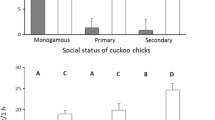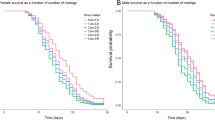Summary
The reproductive success of female house sparrows mated with polygynous males depended to some extent on the aid received from their mates. Polygynous males fed nestlings at the same rate as monogamous males although polygynous males gave aid almost exclusively to one of their mates (the “preferred”). As a consequence, the number and quality of young raised by “preferred” females were similar to those of monogamous females, whereas nonaided females experienced a reduction of clutch size, hatching success, and fledgling quality. Males aided the harem female that hatched her clutch earliest (in 11 out of 12 cases). However, harem females that laid eggs earliest (i.e., the potential “preferred”) lost eggs and/or nestlings more frequently than harem females that delayed laying. This resulted from competing females' infanticide suited for redirecting males' aid. All polygynously mated females delayed the start of a new clutch and reproduced fewer times per season than monogamous females. Consequently, monogamy seems to be the optimum mating situation for females; whereas polygynous males raised more young per year than monogamous males, interference between harem females reduced their maximum expected success.
Similar content being viewed by others
References
Alatalo RV, Carlson A, Lundberg A, Ulfstrand S (1981) The conflict between male polygamy and female monogamy: the case of the pied flycatcher Ficedula hypoleuca. Am Nat 117:738–753
Alatalo RV, Lundberg A, Stahlbrandt K (1982) Why do pied flycatcher females mate with already-mated males. Anim Behav 30:585–593
Alatalo RV, Gottlander K, Lundberg A (1988) Conflict or cooperation between parents in feeding nestlings in the pied flycatcher Ficedula hypoleuca. Ornis Scand 19:31–34
Breiehagen T, Slagsvold T (1988) Male polyterritoriality and female-female aggression in pied flycatchers Ficedula hypoleuca. Anim Behav 36:603–606
Breitwish R, Ritter RC, Zaias J (1986) Parental behavior of a bigamous male northern mockingbird. Auk 103:424–427
Carlson BG, Hornfeldt B, Lofgren O (1987) Bigyny in Tengmalm's owl Aegolius funereus: effect of mating strategy on breeding success. Ornis Scand 18:237–243
Coulson JC, Thomas CS (1983) Mate choice in the kittiwake gull. In: Bateson (ed) Mate choice. Cambridge University Press, Cambridge, pp 361–376
Crook JR, Shields WM (1985) Sexually selected infanticide by adult male barn swallows. Anim Behav 33:754–761
Davies NB (1985) Cooperation and conflict among dunnocks, Prunella modularis, in a variable mating system. Anim Behav 33:628–648
Dyrcz A (1986) Factors affecting facultative polygyny and breeding results in the great reed warbler (Acrocephalus arundinaceus). J Ornitol 127:447–461
Emlen ST, Oring LW (1977) Ecology, sexual selection, and the evolution of mating systems. Science 197:215–223
Ezaki Y (1981) Female behaviour and pair relation of the polygynous great reed warbler Acrocephalus arundinaceus (Aves: sylviinae). Physiol Ecol Jpn 18:77–91
Halliday TR (1978) Sexual selection and mate choice. In: Krebs JR, Davies NB (eds) Behavioural ecology. An evolutionary approach. Blackwell Scientific Publications, Oxford, pp 180–213
Hrdy SB (1979) Infanticide among animals: a review, classification and examination of the implications for the reproductive strategies of females. Ethol Sociobiol 1:13–40
Hurly TA, Robertson RJ (1984) Aggressive and territorial behaviour in female red-winged blackbirds. Can J Zool 62:148–153
Hurly TA, Robertson RJ (1985) Do female red-winged blackbirds limit harem size?, a removal experiment. Auk 102:205–209
Lamprecht J (1987) Female reproductive strategies in bar-headed geese (Answer indicus): why are geese monogamous? Behav Ecol Sociobiol 21:297–305
LaPrade HR, Graves HB (1982) Polygyny and female-female aggression in red-winged blackbirds (Agelaius phoeniceus). Am Nat 120:135–138
Leonard ML, Picman J (1987) Female settlement in marsh wrens: is it affected by other females? Behav Ecol Sociobiol 21:135–140
Lightbody JP, Weatherhead PJ (1987) Interactions among females in polygynous yellow-headed blackbirds. Behav Ecol Sociobiol 21:23–30
Lindén M (1988) Reproductive trade-off between first and second clutches in the great tit Parus major: an experimental study. Oikos 51:285–290
Maynard-Smith J (1977) Parental investment: a prospective analysis. Anim Behav 25:1–9
Muldal AM, Moffatt JD, Robertson RJ (1986) Parental care of nestlings by male red-winged blackbirds. Behav Ecol Sociobiol 19:105–114
Mumme RL, Koenig WD, Pitelka FA (1983) Reproductive competition in the communal acorn woodpecker: sisters destroy each other's eggs. Nature 306:583–584
Murphy EC (1978) Seasonal variation in reproductive output of house sparrows: the determination of clutch size. Ecology 59:1180–1199
Nur N (1984) The consequences of brood size for breeding blue tits II: nestling weight, offspring survival and optimal brood size. J Anim Ecol 53:497–517
O'Connor RJ (1984) The growth and development of birds. Wiley, Chichester
Patterson CB, Erckmann WJ, Orians GH (1980) An experimental study of parental investment and polygyny in male blackbirds. Am Nat 116:757–769
Perrins CM (1965) Population fluctuations and clutch size in the great tit, Parus major L. J Anim Ecol 34:601–647
Rowley I (1983) Re-mating in birds. In: Bateson P (ed) Mate choice. Cambridge University Press, Cambridge, pp 361–376
Royama T (1966) Factors governing feeding rate, food requirements and brood size of nestling great tits Parus major. Mate Choice 108:313–347
Sherman PW (1981) Reproductive competition and infanticide in Belding's ground squirrels and other animals. In: Alexander RD, Tinkle D (eds) Natural selection and social behavior. Chiron Press, New York, pp 311–331
Simmons RE, Smith PC, MacWhirter RB (1986) Hierarchies among northern harrier (Circus cyaneus) harems and the costs of polygyny. J Anim Ecol 55:755–771
Smith H, Kallander H, Nilsson JA (1987) Effect of experimentally altered brood size on frequency and timing of second clutches in the great tit. Auk 104:700–706
Stacey PB, Edwards TC (1983) Possible cases of infanticide by immigrant females in a group-breeding bird. Auk 100:731–733
Tinbergern JM (1981) Foraging decisions in starlings Sturnus vulgaris L. Ardea 69:1–67
Trivers RL (1972) Parental investment and sexual selection. In: Campbell B (ed) Sexual selection and the descent of man, 1871–1971. Aldine, Chicago, pp 136–179
Vehrencamp SL (1977) Relative fecundity and parental effort in communally nesting anis, Crotophaga sulcirostris. Science 197:403–405
Veiga JP (1990a) Infanticide by male and female house sparrows. Anim Behav 39:496–502
Veiga JP (1990b) A comparative study of breeding adaptations in house and tree sparrows. Auk 107:45–59
Westneat DF (1988) Male parental care and extrapair copulations in the indigo bunting. Auk 105:149–160
Wittenberger JF (1979) The evolution of mating systems in birds and mammals. In: Marler P, Vandenbergh JG (eds) Social behavior and communication. Plenum Press, New York, pp 271–349
Wittenberger JF, Tilson RL (1980) The evolution of monogamy: hypotheses and evidence. Annu Rev Ecol Syst 11:197–232
Yasukawa K, Searcy WA (1982) Aggression in female red-winged blackbirds: a strategy to ensure male parental investment. Behav Ecol Socio biol 11:13–17
Author information
Authors and Affiliations
Rights and permissions
About this article
Cite this article
Veiga, J.P. Sexual conflict in the house sparrow: interference between polygynously mated females versus asymmetric male investment. Behav Ecol Sociobiol 27, 345–350 (1990). https://doi.org/10.1007/BF00164005
Received:
Accepted:
Issue Date:
DOI: https://doi.org/10.1007/BF00164005




